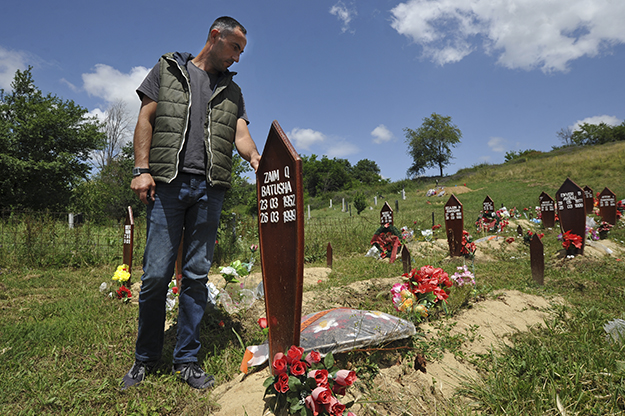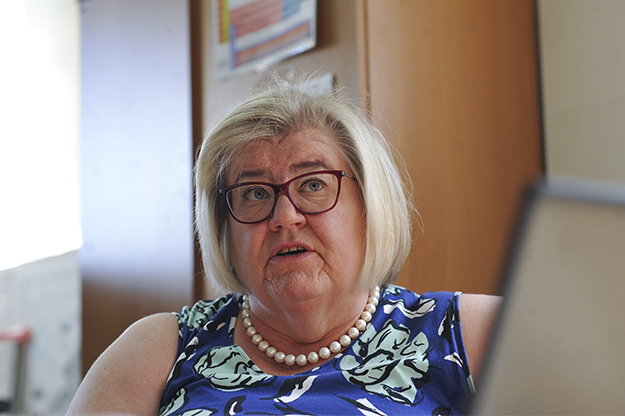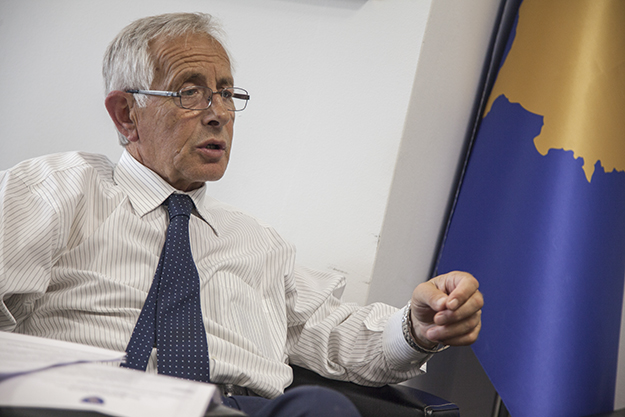“I am not sure whether this is the last reburial of my father’s remains,” says Fitim Batusha from the village of Krusha e Vogël. “My father was identified and buried a long time ago, but more remains keep turning up, and this is causing us anguish,” he says.
A month ago, Batusha was notified by the Department of Forensic Medicine that a further two bones that belong to his father Zaim Batusha, had been identified, despite the fact that he was buried in 2007. On May 25, Batusha reunified his father’s remains.
The remains of 19 other former residents of Krusha e Vogël have also had to be reunified after being buried in the village cemetery, where 45 people who were killed in the Kosovo war now rest.
It seems that the wounds of the Batusha family and others from Krusha e Vogël remain eternally open, not only due to the reunification of identified bones years after they have buried their loved ones, but also because of the fact that they have only found approximately 50 bodies (figures vary between institutions) from the 113 residents that were murdered on March 26, 1999. The remaining missing persons from Krusha e Vogël are among the 1,650 persons who are still identified as missing since the last war in Kosovo.

Fitim Batusha has experienced both the trauma of reburying his father and the pain of never discovering his two missing brothers. Photo: Atdhe Mulla / K2.0.
For Batusha, opening his father’s grave to reunify his bones is not the only thing that brings him pain. With a focused gaze and a clear narrative, he explains that his two brothers, Feim and Mërgim Batusha, are also among the missing, as well as eight close relatives of whose fate they know nothing about.
Besides continuously hoping that one day his brothers’ remains will be found, Batusha also fears that finding their bodies will not put an end to the long-standing suffering that his family has experienced. It’s not surprising when taking into account that the family have just reunited his father’s remains, years after he was initially buried. He is still not convinced this will be the last time that they will open his father’s grave.
Batusha feels that institutions have been “irresponsible” in the way they have dealt with the families. Convincing some of his relatives to go through the process of reunifying his father’s remains was challenging, as many were upset that the case was being reopened after so many years.
Arsim Gërxhaliu has been the Head of Kosovo’s Department of Forensic Medicine since it was established in 2009. Gërxhaliu says that he understands where the relatives of missing persons are coming from, and acknowledges the suffering that they have endured for 19 years.
Gërxhaliu argues that the reunification of bones is happening due to the complex nature of the crimes committed. During the Kosovo war, multiple burials and exhumations were conducted by the Serbian forces, aiming to cover up traces of crimes.
“In some cases we found a person’s body parts in Vërmicë [near Prizren] and later we found more body parts belonging to the same person, 500 km away in Batajnicë [a Belgrade suburb],” he explains. “Serbian forces exhumed bodies in Prizren so as to cover up traces of their crimes, but some bones were left behind, as the body has 208 bones.”

The morgue in Prishtina contains 300 sets of unidentified remains, presenting a challenge to the head of the Department of Forensic Medicine, Arsim Gërxhaliu. Photo: Atdhe Mulla / K2.0.
Recovering and identifying new bones presents a challenge to the department. “What are we to do when we find them?” asks Gërxhaliu rhetorically, before adding that in some cases the relatives of victims told them not to ‘reopen our wounds,’ refusing to reunify their deceased relatives’ remains. “This is their legal right, as it is our legal obligation to inform them when we find body parts.”
According to the Department of Forensic Medicine, in the morgue in Prishtina there are over 300 sets of remains yet to be identified, dating back to different periods, and each with unique profiles. Gërxhaliu explains that many bone parts that have been found have often turned out to be from past historical periods, which makes identification more difficult.
“During our work we have found remains from the Second World War and the period of [former Yugoslav vice-President, Aleksandar] Ranković — we found coins dating back to that period,” he explains.
For a long time, this situation has added to the anguish experienced by the Batusha family. “They are telling us that there are 300 remains and we are saying to ourselves ‘ah, maybe there is someone from our family.’ The bones have been there for years, unidentified.”
A complex process and an institutional mix up
For years, as families of the disappeared have been faced with endless pain, the process of identifying human remains has included many local and international institutions who have conducted the exhumation, identification and reunification of human remains.
In June 2002, the Office for Missing People and Forensics (the predecessor to Kosovo’s Department of Forensic Medicine) was created as part of the the United Nations Interim Administration Mission in Kosovo’s (UNMIK) legal office.
In the years that preceded the foundation of the department, thousands of bodies were identified using “traditional” methods, mainly through attire found on the body (clothes, jewelry, etc.), leading to the possibility that mistakes could have been made.
Moreover, in the years immediately after the war, over 2,000 other bodies were identified by relatives in “traditional” forms, mainly through attire found on the body (clothes, jewelry, etc.), adding to the possibility of making mistakes.

Mistakes made in the past and an incomplete set of blood samples make the process for identifying the remains in the morgue even more challenging. Photo: Atdhe Mulla / K2.0.
Gërxhaliu says that the 300 human remains in the morgue are not consistent with the blood samples provided by relatives to the International Commission on Missing Persons (ICMP). But another aspect that makes identification more difficult is that some families did not provide blood samples of their missing relatives, making it impossible to identify victims through DNA.
Although it is estimated that the number of people that have refused to give blood is low, according to data provided to K2.0 by EULEX, the number stands at around 20 families.
Tarja Formisto is the deputy director of the Forensics Institute at the European Union Rule of Law Mission in Kosovo (EULEX), having worked with the mission since it began in 2008. Formisto believes that families may have refused to give blood for a number of different reasons.
She suggests that some families of missing persons have been displaced from Kosovo. Among the 1,650 missing persons are hundreds of Serbs, Roma, Ashkali and Egyptians, but relevant institutions do not classify on the basis of ethnicity because they do not have exact data regarding the nationalities of missing persons. Formisto also believes that other families have been convinced that their loved ones are still alive, and do not wish to enter a process that may prove otherwise.
This refusal to give blood has added to the difficulty in identifying the over 300 human remains which are located in the morgue. According to Formisto, soon these unidentified bones will be buried in a specific location which has been allocated by the municipality of Prishtina.
Local or international responsibility?
The identification procedure is a complex process which includes many different institutions. Since 2004, ICMP has conducted blood sample collection in Kosovar missing persons cases. In the past, DNA tests in these cases were conducted in Bosnia and Herzegovina, whereas now they are conducted in the Hague, and cost over 500 U.S. dollars per person.
There is no clear explanation as to why Kosovo doesn’t use its laboratory for conducting DNA tests for identifying the remains of victims of war crimes, but does so for other crimes. Gërxhaliu says that he made requests years ago, but according to him, the decision was in the hands of international organizations, who did not allow such a thing.
The issue of dealing with war crimes, and consequently the issue of missing persons and the identification of human remains, has always been led by international organizations: from UNMIK, to EULEX’s current mandate.
The EULEX mandate, extended in 2016, is set to expire on June 14. Discussions over its new role regarding war crimes, a field in which the mission has executive powers, are currently in the final phase.
Prenk Gjetaj, the head of the Government Commission for Missing Persons, insists that jurisdiction regarding the issue of human remains must be handed over to Kosovo state institutions. “I think the time has come for this process to be conducted by locals,” he says.

Head of the Department of Forensic Medicine, Arsim Gërxhaliu believes his department has the desire to handle responsibilities for identifying missing persons but have been left ill prepared by a lack of training and investment. Photo: Atdhe Mulla / K2.0.
Gërxhaliu, the head of Kosovo’s Department of Forensic Medicine agrees in principle but is unsure of the practicalities of such a move. He states that his institute has the willpower but not the capacity to take over these responsibilities, due to the fact that governments have continuously neglected the department, failing to increase its human and technical capacities.
The missing persons division within the Department of Forensic Medicine has 10 employees, whereas the department itself has a total of 60. It also lacks the necessary qualifications for taking over from EULEX. Gërxhaliu criticizes both EULEX and the different governments that have led Kosovo for their failure to lend a helping hand. “In these 18 years, we have not managed to certify even the two forensic anthropologists that we have,” says Gërxhaliu.
Formisto agrees that local authorities do not have the capacity to take over the process of identifying missing persons and human remains. But she also believes that there is lack of willingness, which certificates will not help overcome. “Kosovar authorities lack academic preparation,” she states. “They don’t have any academic background, they don’t have enough experience to do that and especially they don’t have will to do that.”

Deputy Director of EULEX’s Forensics Department, Tarja Formisto, feels that her organization has become an easy target, and that there is a lack of willingness from Kosovar institutions to take responsibility. Photo: Atdhe Mulla / K2.0.
Formisto also feels that EULEX faces accusations because it is an easy target for justifying tasks left unfinished by others. “If you don’t care what happened to these people, and if you are not willing to find them, you sit behind a desk and you talk nonsense,” she says.
Formisto seems disappointed with the dedication shown by locals and the morgue’s staff. “When I started creating the inventory of bones, it didn’t take long for me to realize that no-one was interested to work in the basement [where the human remains are],” she says. “7 a.m. was too early for them to start work.”
Politically ignored
Technical problems have contributed to negligence towards the identification process and the mission to find the remaining 1,650 missing persons.
However, the issue of missing persons has not been a priority at the political level either. Past Kosovo governments have never discussed the issue of missing persons and reparations in the dialogue for normalizing relations with Serbia, which has been mediated by the European Union since 2011.
It is said that this year Kosovo and Serbia will reach a “final” agreement for normalization, however it is unclear whether the issue of missing persons will be addressed within this agreement. Relatives of missing persons are unhappy with the level of dedication shown by the Kosovo government and the fact that the issue of missing persons is yet to be addressed.
For Batusha, Kosovar institutions have continuously shown their indifference towards the issue of missing persons. “If only we were more insistent, we could have set conditions,” he says. “If they sign a final agreement which doesn’t solve the issue of missing persons, it will be a catastrophe for us relatives of the victims — murder all over again, and proof that nothing has been done.”

Head of the Government Commission on Missing Persons, Prenk Gjetaj, believes that the European Union haven’t given the fate of missing persons enough weight in the dialogue. Photo: Majlinda Hoxha / K2.0.
On the other hand, Prenk Gjetaj blames international influences for not allowing such conditions. “The European Union has not shown interest in including the issue of missing persons in the political dialogue, or conditioning Serbia’s European path with the fate of the missing,” he told K2.0.
In contrast to Gjetaj, Formisto feels that political will has been lacking on both sides, and according to her, the reasons for this are clear. “Those who are in power in Kosovo and also Serbia… why should they investigate the crimes they have done?” she concludes.
As institutions continue to show indifference, the whole situation is characterized by a lack of clarity and a mix up between local and international institutions in the process for identifying the hundreds of bones that are in the morgue. Meanwhile, the relatives of victims continue to live with the hope and anguish of expecting to be informed about the next reunification of their loved ones’ remains, or the discovery of a disappeared person.K
Feature image: Atdhe Mulla / K2.0.
Edited by Leurina Mehmeti and Jack Robinson
Correction: This article was amended on July 2, 2018. The article initially stated that the International Criminal Tribunal for the Former Yugoslavia was involved in the identification of bodies after the Kosovo war. This information was inaccurate. Exact figures regarding those missing from Krusha e Vogël were also altered due to conflicting information.

